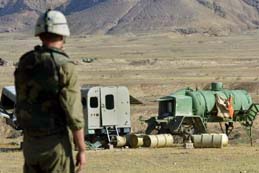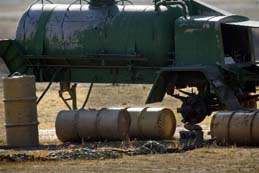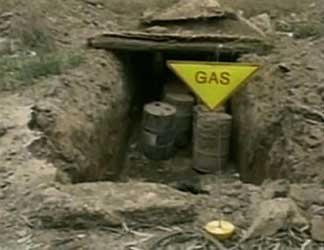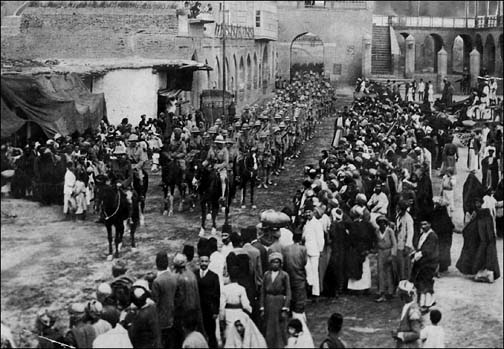
May 2003
The Great Chemical Weapons Hoax
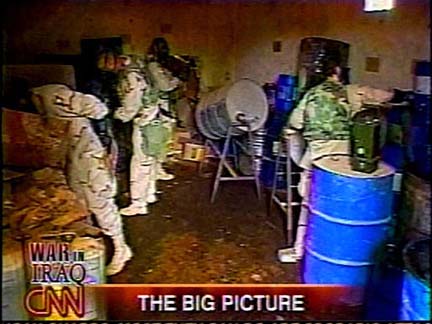
Part 1
On the evening of March 20, U.S. president George W. Bush ordered the dropping of “bunker buster” bombs on Baghdad in a blatant attempt to assassinate Iraqi president Saddam Hussein. On April 10, a Marine from Brooklyn placed the American flag over the head of a statue of Hussein in the Iraqi capital in a triumphant gesture of Yankee imperialist conquest. Three weeks was more than the Pentagon planners had anticipated, as they hadn’t factored into their war games the guerrilla strikes by militias in the south against the Americans’ vulnerable supply lines. But despite brave Iraqi resistance, the U.S. military juggernaut with its vastly superior firepower rolled on. Bombing thousands of Iraqis and mowing down survivors, they left a trail of death all along the road to Baghdad.
Little of this was reported in the news accounts by “embedded” journalists,
who instead carried out their task of glorifying the fighting prowess of
the “coalition” forces. One of the few half-way honest dispatches in the
imperialist press reported:
“Throughout the march north across the desert, the human toll of war was evident, at the border outposts, in the streets of the village of Kifl, along the banks of the Euphrates, in bunkers along canals, and finally at the airport west of Baghdad.
“The corpses of scores of Iraqis lay in the sun, twisted, starting to rot. Some were in uniform; some were not. Most of the dead were young men, no older than the soldiers who killed them. Many were burned beyond recognition in vehicles destroyed by American air and artillery bombardments.
“For the soldiers of the First Brigade, most of them in their early 20’s, it was their first experience of killing, their first encounter with death on such a scale. Some showed revulsion, a sense of unease, and concern about what their families at home might think. Others simply gawked, apparently impassive. A few became physically sick.”
–Steven Lee Myers, “Doubt and Death on the Drive to Baghdad,” New York Times, 13 April
Of course, readers of the Western press and viewers of Western television never saw the carnage, for such macabre scenes were carefully excised from the media coverage, mostly by the self-censorship of the patriotic press. You can probably count on the fingers of one hand the number of Iraqi corpses that you saw in the sanitized virtual war beamed to the audience at home. “Image control” has become a key part of the U.S. military’s battlefield management. This is true not only for the fighting, but also of the batteries of war propaganda softening up the home front and battering reluctant imperialist allies. Key to this was the declared war aim, the casus belli.
|
I. U.S. Pretexts for Colonial Invasion
of Iraq
U.S. soldier
at fuel dump near Baiji. Initial reports claimed drums contained mustard
gas and sarin nerve gas. Analysis showed: rocket fuel. (Photo: Brennan Linsley/AP)
The Bush regime has had problems from the beginning in settling on the alleged purpose of this war. The day American bombs started falling on Afghanistan a year and a half ago, Vice President Dick Cheney declared that the war the United States was unleashing “may never end. At least, not in our lifetimes” (Washington Post, 7 October 2001). The invasion of Iraq is the second episode of Cheney’s “war without end” and the first under the Bush Doctrine of “preemptive war,” which the U.S. commander in chief announced at West Point last year. This was later elaborated as a National Security Strategy of the United States in September. Launching unprovoked wars of imperialist aggression is hardly new, of course. That, after all, was the main charge on which the Nazi leaders were prosecuted by the victorious Allies at the war crimes trials at Nuremburg following World War II. U.S. rulers have traditionally claimed to be waging defensive wars against an attack or intervening in a conflict in the name of lofty ideals (“war for democracy”). How, then, would they market the unprovoked war on Iraq? Liberal critics made much of the fact that the Bush administration offered several different reasons for the invasion of Iraq. In one version, it was about retaliation for 11 September 2001 (“9-11”), even though the hijackers who slammed airplanes into the World Trade Center that day had no connection to Iraq. The reputed intellectual author of that attack, Osama bin Laden, called Saddam Hussein “an apostate, an infidel and a traitor to Islam.” According to the polls, the White House spin doctors managed to convince a majority of the U.S. population that Hussein was behind 9-11. But this wouldn’t sell well overseas. So they came up with version II, particularly for external consumption: that Hussein possessed monster weapons that threatened the world. This was the theme of the British government’s September 2002 White Paper, Iraq’s Weapons of Mass Destruction, a compilation of outright fabrications and outdated information lifted from a graduate student’s decade-old thesis. The introduction by Prime Minister Tony Blair declaimed that UN weapons “inspectors must be allowed back in to do their job properly…or the international community will have to act.” When Iraq let the UN inspectors return in November, this excuse fell flat. So they came up with version III: that the Hussein government was an oppressive regime and this was a “war of liberation” of the Iraqi people. Now that U.S. general Tommy Franks has held his victory ceremony in Baghdad and the imperial viceroy, U.S. general Jay Garner, is ensconced in Hussein’s Republican Palace, it’s payback time. No matter that they haven’t captured or (apparently) killed the Iraqi strong man, or that the American “liberators” were met by Kalashnikovs instead of crowds greeting them with flowers and kisses; forget about the mass demonstrations against colonial occupation. The war hawks are crowing “we told you so” against “lily-livered liberals,” imperialist doves and “cheese-eating surrender monkeys” (the French) who tried to delay the invasion by appealing to the United Nations. The doves respond by asking whatever happened to the fabled weapons of mass destruction (WMD) that Hussein was supposed to have, allegedly deployable “within 45 minutes of an order to use them” (Tony Blair)? “Where Are They Mr Blair” headlined the London Independent on Sunday (20 April), adding: “Not one illegal warhead. Not one drum of chemicals. Not one incriminating document. Not one shred of evidence that Iraq has weapons of mass destruction in more than a month of war and occupation.” The London Guardian (25 April) chimed in with a leader (editorial), “Credibility Gap Widens on Iraq’s Weapons,” lamenting “the signal failure so far to locate a warm-ish peashooter, let alone a smoking gun.” Across the Atlantic, the New York Times (26 April) editorialized: “This page agreed with the president's conviction that there were world-threatening weapons in Iraq, if not the manner in which the United States went to war. We still tend to believe they are there” (“Assessing the Weapons Search”). But with “the most obvious storage sites coming up empty,” the Times editors gave the White House and Pentagon some pointers as to what might constitute a warmish peashooter: finding mustard gas or nerve agents in artillery shells and missiles would be ducky, but “precursor chemicals” alone just won’t do it. Next-best “would be evidence that Iraq was working with the smallpox virus”; alternatively, “even 15-year-old stocks of liquid anthrax would be alarming.” If that doesn’t pan out, “discovery now that Iraq had obtained either highly enriched uranium or weapons-grade plutonium…would be a real shock,” and “almost as disturbing would be full-scale enrichment facilities,” which might do in a pinch. The Times’ Idiot’s Guide to finding a justification for imperialist war underlines the fact that all the hoopla about Hussein’s hypothetical “WMD” was just a ploy to speed up the attack on Iraq (in the case of the hawks) or to slow it down (in the case of the doves). It never had anything to do with an illusory Iraqi “threat” to the imperialists – much less to the “American people” – but was only a cover for launching a horrendous slaughter. The job of UN “inspectors” was to find the excuse for the Pentagon to test drive its “Massive Ordnance Air Blast” (dubbed the “Mother of All Bombs,” or MOAB, for short, recalling the biblical prophecy in Jeremiah 48:42, “Moab will be destroyed as a nation because she defied the Lord”) which would truly carry out mass destruction. When the head of the UNMOVIC chemical weapons inspection operation Hans Blix came up empty-handed, the pretext was simply discarded and the bombs began falling. To liberal pleas to let the Blix boys back in, the response from Bush and Blair is: they had their chance, no way is the UN getting in on this act again. Instead, the Pentagon had the Times’ own (more or less)
germ warfare “expert,” Judith Miller, “embedded” with the 75th Exploitation
Task Force. Her assignment is to validate any pseudo-proof of Iraqi WMD
the U.S. military “exploiters” come up with. But after visiting more than
half the 150 sites on U.S. intelligence agency lists, she reported that
“military experts said they now believed they might not find large caches
of illicit chemicals or biological agents, at least not in Iraq” (New
York Times, 25 April). Not to worry, say her handlers. “I think there's
going to be skepticism until people find out there was, in fact, a weapons
of mass destruction program,” said George Bush in an interview on NBC-TV
(24 April). “And so we will find them.” Just to make sure, they’re bringing
in new teams of weapons experts, coordinated by the Pentagon’s Defense Threat
Reduction Agency. This is the outfit which has been secretly developing
a more potent strain of anthrax – for “defensive” purposes, of course. The
DTRA will be assisted by two private companies, Raytheon Corporation (manufacturers
of the Patriot “Scud-buster” missile which missed 80 percent of Iraqi missiles
in Gulf War I) and the Kellogg, Brown & Root division of Vice President
Dick Cheney’s Halliburton Corporation!
U.S. military
brought reporters to agricultural facility near Karbala, April 7, posting
sign announcing drums contained poison gas. Initial claim: sarin and tabun nerve gas and blister agent lewisite.
Result of testing: pesticide.
(Photo: ABC News)
Rest assured that they will “find” something, even if it has
to be planted, as is by now widely expected. The Bush war marketeers wouldn’t
hesitate for a minute, given the stakes; indeed, that is doubtless why
they are bringing in their back-up team. The only question is how crude
a fabrication it will be. After all, these are the people who tried to
pass off a forged memo from an official in the African republic of Niger
about an Iraqi attempt to buy enriched uranium! (Niger has no facilities
to enrich uranium, the official in question had been out of office for ten
years, etc.) The warmongers in Washington clearly don’t give a damn whether
they are believed. Their real war aim is to demonstrate overwhelming U.S.
power to secure untrammeled American imperialist hegemony in the New World
Order proclaimed by George Bush Sr. The rest – war on “WMD,” war on terror,
war of liberation – is eyewash. Hermann Göring, the Nazi Luftwaffe (air
force) commander, explained it to an American intelligence officer in his
cell in Nuremburg: “After all, it is the leaders of the country who determine the policy and it is always a simple matter to drag the people along. ... Voice or no voice, the people can always be brought to the bidding of the leaders. That is easy. All you have to do is tell them they are being attacked, and denounce the peacemakers for lack of patriotism and exposing the country to danger.” This exactly the mindset of U.S. rulers today as they seek to “shock and awe” the world into submission to their Diktat. The unelected American president added the Bush codicil – “You can fool some of the people all the time, and those are the ones you have to concentrate on” – slyly modifying Abraham Lincoln’s famous dictum at the Washington Gridiron Club a few months after stealing the Florida vote and the 2000 U.S. election. From a Marxist perspective, the whole hullabaloo about atomic,
chemical and biological weapons that the Iraqis may have, could have or
would have if they could, is nothing but a charade, sucker bait for the
liberals who get queasy at the slaughter of imperialist war. As Lenin insisted
in the first imperialist world war: “Our attitude towards war … is fundamentally different from that of the bourgeois pacifists (supporters and advocates of peace) and of the anarchists. We differ from the former in that we understand the inevitable connection between wars and the class struggle within a country; we understand that wars cannot be abolished unless classes are abolished and socialism is created; we also differ in that we regard civil wars, i.e., wars waged by an oppressed class against the oppressor class, by slaves against slave-holders, by serfs against landowners, and by wage workers against the bourgeoisie, as fully legitimate, progressive and necessary…. “For example, if tomorrow, Morocco were to declare war on France, or India on Britain, or Persia or China on Russia, and so on, those would be ‘just,’ and ‘defensive’ wars, irrespective of who attacked first; any socialist would wish the oppressed, de-pendent and unequal states victory over the oppressor, slave-holding and predatory ‘great’ powers.” – V.I. Lenin, Socialism and War (September 1915) Leninists judge the character of a war by the class and national forces arrayed against each other. In the case of a war by an imperialist country, no matter how “democratic” it pretends to be, against a colonial or semi-colonial country, no matter how brutal and anti-democratic the current dictator, class-conscious workers are duty-bound to defend the oppressed nation and to fight for the defeat of the imperialist oppressor. In the U.S. imperialist war on Iraq the League for the Fourth International stands on the side of Iraq, as Trotskyists did in Gulf War I as well. While denouncing Saddam Hussein, the butcher of Kurds, Shiites and communists, who was installed with the aid of U.S. imperialism and for years enjoyed Washington’s support, we defended the right of Iraq’s government to possess any weapons needed to fight the imperialists. That includes nuclear, chemical and bioweapons which the Pentagon has in superabundance and which American imperialism has repeatedly used against oppressed peoples and the civilian populations of its imperialist rivals, killing millions – far more than a tinpot nationalist dictator like Hussein could ever do. We opposed demands on Iraq to admit UN “inspectors,” whose task was to trigger imperialist aggression (and who often were literally U.S. spies). And while giving no credence to squabbles between imperialist hawks and doves over Iraqi “weapons of mass destruction,” we expose the falsehood and sophistry of the Great Chemical Weapons Hoax that was the main pretext for the imperialist war on Iraq. The battle cry from Washington over Iraqi chemical warfare
(CW), biological warfare (BW) and nuclear weapons programs is shameless
hypocrisy coming from the mouths of the U.S. imperialists who nuked Hiroshima
and Nagasaki, who used chemical weapons such as napalm and phosphorous bombs
in Korea, who used napalm and Agent Orange on a massive scale in Vietnam.
Besides which, the chemical arms which Iraq actually did obtain were supplied
to it by Washington, to be used against Iranian forces in the 1980-88 Iran-Iraq
war. Iraq’s chemical plants, now alleged to be “dual-use facilities,” were
built by none other than Britain and Germany. And in Iraq, chemical weapons
were first used against the population by the British colonialists in suppressing
a revolt in 1920. This is part of the hidden history of the Iraq war that
the imperialist invaders are desperate to cover up. |
|
II.
Britain Used Chemical Arms on 1920 Iraq Revolt
It all goes back to the seizure of the Near East
by the Western powers during and after World War I. As Marxists declared
at the time, that was not a war to “make the world safe for democracy,”
as U.S. president Woodrow Wilson sanctimoniously claimed. Rather, it was
over the division of the world by the imperialists and the redistribution
of their respective colonies. WWI saw the break-up of the Ottoman Empire
in the Near East, whose capital Constantinople became Istanbul, the metropolis
of modern Turkey. Out of the remnants of that decrepit empire, a series
of artificial states were created which arbitrarily divided up and threw
together various peoples of the Arab East under puppet monarchs imposed
by the colonialists (see “Mr. Sykes and Monsieur Picot Carve Up the Near
East”). Under League of Nations “mandates,” France got Syria and Lebanon,
while Britain got Palestine, Jordan and Iraq. Naturally, the imperialist
“democracies” didn’t bother to consult the populations of the countries
involved. The birth of Iraq was presided over by Winston Churchill,
an arrogant, brutal colonialist and imperialist who to this day is honored
as a “statesman” in bourgeois histories. At the time Churchill was British
secretary of state for the colonies. He had earlier promised Arabian ruler
Sharif Hussein to install his son, Feisal, as ruler of Syria. When the French
grabbed Damascus in the diplomatic horse-trading, Churchill gave Feisal the
lands formerly known as Mesopotamia, lying between the Tigris and Euphrates
Rivers, as a consolation prize. Repeatedly from 1919 on, the population of
what is now Iraq rose up against the Hashemite ruler and his British patrons.
In June 1920, a full-scale rebellion broke out. British garrisons were taken
by surprise as the revolt spread throughout the lower Euphrates valley. In
August, the insurgents declared a provisional Arab government. But by February
1921, the revolt had been crushed, with between 8,000 and 9,000 rebels killed.
This was accomplished mainly through the use of air power, by the Royal Air
Force (RAF), which mercilessly bombed the insurgents using incendiary weapons
and poison gas. Before the outbreak of the rebellion, the RAF asked Churchill
in 1919 for permission to use chemical weapons “against recalcitrant Arabs
as an experiment.” Churchill (then secretary of state for war) in turn
asked experts if it would be possible to use “some kind of asphyxiating
bombs calculated to cause disablement of some kind but not death…for use
in preliminary operations against turbulent tribes.” He added: “I do not
understand this squeamishness about the use of gas. I am strongly in favour
of using poison gas against uncivilised tribes” which “spread a lively terror.”
General Sir Aylmer Haldane wrote that poison gas was more useful against
the hilly Kurdish redoubts, while “in the hot plains…the gas is more volatile”
(quoted in Geoff Simmons, Iraq: From Sumer to Saddam
[MacMillan Press, 1994]). In fact, the weapons used by the RAF in its “civilizing
mission” against the “turbulent tribes” were quite lethal. The British cabinet
was squeamish, but Churchill argued that use of gas should not be prevented
“by the prejudices of those who do not think clearly.” Eventually, poison
gas was used on Iraqi rebels, with what the illustrious “statesman” described
as “excellent moral effect” (quoted in David Omissi, Air Power and Colonial
Control. The Royal Air Force, 1919-1939 [Manchester University Press,
1990]). The RAF was also used to bomb and strafe Kurds and Iraqis
before, during and after the revolt. A series on the “Secret History” TV
program of Britain’s Channel 4 on “The RAF and the British Empire” (6 July
1992) interviewed a squadron leader, who said that if the tribespeople “were
doing something they ought not to be doing then you shot them.” A commander
remarked: “If the Kurds hadn’t learned by our example to behave themselves
in a civilised way then we had to spank their bottoms. This was done by bombs
and guns.” A colonel with the Royal Artillery noted in his diary that the
burning of Arab villages made “a wonderful sight at night.” Earlier, Wing
Commander Arthur Harris emphasized, “The Arab and Kurd now know what real
bombing means in casualties and damage. Within forty-five minutes a full-size
village can be practically wiped out and a third of its inhabitants killed
or injured.” The bloodthirsty Harris was later known as “Bomber Harris” (or,
more to the point, Butcher Harris) during World War II, when he designed
the infamous firebombing of Dresden, Germany in February 1945 (see “U.S./British
Massacre at Dresden”). As the Pentagon is doing today, Britain used the suppression
of the Iraqi revolt in order to test out new weapons. Devices developed
for use against tribal villages included forerunners of napalm, air-to-ground
missiles and fragmentation bombs. An Air Ministry list included:
Gertrude Bell, the Oriental Secretary in the Colonial Office,
described a demonstration of the new technology: “They had made an imaginary
village…and the first two bombs dropped from 3000 feet, went straight into
the middle of it and set it alight…. Then they dropped bombs all round
it, as if to catch the fugitives and finally fire bombs which even in the
brightest sunlight made flares of bright flame in the desert. They burn
through metal and water won’t extinguish them. At the end the armoured
cars went out to round up the fugitives with machine guns” (quoted in Simons,
Iraq: From Sumer to Saddam, which brings together reports
of Britain’s use of poison gas and terror bombing of the civilian Iraqi
population). Today the British Foreign and Commonwealth Office, successor
to the Colonial Office, professes horror at the suffering of the Kurds
under Hussein’s rule, which has “included the use of chemical weapons”
(Saddam Hussein: Crimes and Human Rights Abuses [November 2002]).
Yet this is the bloody history of the British imperialists who claim to
be friends of the Kurds! In March 1917, the commander of the Anglo-Indian
Army of the Tigris, Lt.-General Stanley Maude, issued a proclamation upon
entering Baghdad declaring that “Our armies do not come into your cities
and lands as conquerors or enemies, but as liberators” (Robert Fisk, “The
West Has Been Liberating the Middle East for Centuries,” Independent
[London], 7 March). This is the fiery hell the imperialist “liberators”
visited on the Iraqi people then, as they are doing again today. |
|
III. Spanish and Italian Imperialists Use Poison Gas in Africa Britain was not the only “great power” to engage in indiscriminate bombing and employ chemical arms in their wars of conquest and colonial policing. Indeed, all of the imperialists in the current U.S.-led “coalition of the willing” have used so-called weapons of mass destruction against civilian populations. Spain used poison gas against the Berber rebellion in the Rif region of northern Morocco. The revolt led by Abd el Krim began in 1921, and trounced the Spanish army in July of that year. In response, the Spanish air force “took reprisals against the homelands of tribes who joined the rebels and made lavish use of poison gas” (Omissi, Air Power and Colonial Control). When the rebels continued to advance, proclaiming an independent republic of the Rif, imperialist France dispatched 400,000 troops (led by Marshal Pétain, the future collaborator with Hitler) to aid the Spanish. Entire Rif villages were wiped out by French aerial bombardment and artillery. Today the French Communist Party (PCF) recalls that its forebears called then to stop “immediately the spilling of blood” (L’Humanité, 20 December 2000). Actually, this is a reformist rewriting of history as if the early Communists were nothing but a group of pacifists.. At the time, the PCF proclaimed its solidarity with the independence fighters, organized dock workers strikes refusing to move war materiel to Morocco, and in October 1925 called a general strike against the colonial war. In the mid-1930s, Italy under the fascist Duce Benito Mussolini notoriously used poison gas in its conquest and occupation of Abyssinia (now known as Ethiopia) in East Africa. In December 1935, the commander of the Italian expeditionary force, Marshal Pietro Badoglio, ordered the use of dichlorodiethyl sulfide (mustard gas) against the troops of Ethiopian emperor Haile Selassie. In February 1936, Badoglio sent 200,000 Italian troops against the Ethiopians. As the Ethiopian forces retreated, some 6,000 were killed by poison gas in 600-pound bombs dropped from planes. Celebrating his victory at a ceremony in Rome that May, Mussolini declared: “At last, Italy has her empire... a civilizing empire, humanitarian toward all the peoples of Ethiopia” (see Alberto Sbacchi, Legacy of Bitterness: Ethiopia and Fascist Italy, 1935-1941 [Red Sea Press, 1997]). Altogether a quarter million Ethiopians were killed in this
colonialist slaughter. The response of many liberals and reformists (including
the Stalinized Communist parties, by then wedded to the “popular front”)
was to beseech the League of Nations to intervene, just as today many forlornly
looked to the United Nations as a brake on the U.S./British invasion of
Iraq. But the UN’s predecessor simply washed its hands of the question.
In contrast to the Stalinists’ illusory appeal to the “democratic” imperialists,
Leon Trotsky, the founder of the Fourth International, who together with
V.I. Lenin led the October 1917 Russian Revolution, called instead for the
action of the workers movement in defense of Ethiopia: “Of course, we are for the defeat of Italy and the victory of Ethiopia, and therefore we must do everything possible to hinder by all available means support to Italian imperialism by the other imperialist powers, and at the same time facilitate the delivery of armaments, etc., to Ethiopia as best we can. “However, we want to stress the point that this fight is directed not against fascism, but against imperialism. When war is involved, for us it is not a question of who is ‘better,’ the Negus [the Ethiopian emperor Haile Selassie] or Mussolini; rather, it is a question of the relationship of classes and the fight of an underdeveloped nation for independence against imperialism.” –“The Italo-Ethiopian Conflict” (July 1935), Writings of Leon Trotsky (1935-36) Haile Selassie was no pseudo-progressive bourgeois nationalist, but presided over a regime that practiced slavery (particularly of subjugated minority peoples). Yet Trotsky insisted that the movement for the Fourth International defend Ethiopia against the Italian imperialists just as the Trotskyists today call to defend Iraq and defeat U.S. imperialism and its second-rate imperialist British, Italian, Spanish and Australian allies. |
|
and Terror Bombing Kills Millions Prior to the second imperialist world war, it was primarily the European powers who used poison gas to subdue their colonial subjects. After WWII, the imperialists of what the American war minister Donald Rumsfeld now calls “Old Europe” were increasingly replaced by U.S. imperialism, which took on itself the “white man’s burden” of policing the so-called Third World. Chemical weapons were heavily used by the Pentagon’s expeditionary forces in Korea and Vietnam. In fact, for decades the U.S. was the main producer, purveyor and user of chemical arms, and today it still has what may be the largest stockpile of bio-chemical weapons in the world. This was almost entirely hidden from public view until the 1960s when the U.S.’ use of CBW in Vietnam was exposed and investigative journalist Seymour Hersh published Chemical and Biological Warfare: America’s Hidden Arsenal (Bobbs-Merrill, 1968). This has recently been updated by Judith Miller with Stephen Engelberg and William Broad in Germs: Biological Weapons and America’s Secret War (Simon & Schuster, 2001). As Harvard microbiologist Matthew Meselson notes in his review of Miller’s book (New York Review of Books, 20 December 2001), just as the United States enrolled Hitler’s rocket scientists in its missile programs after World War II, the U.S. also granted immunity from war crimes prosecution to scientists from the Japanese Army’s notorious Unit 731 in exchange for data on Japan’s biological warfare program. That unit had attacked Chinese villages and towns with anthrax, plague and typhoid during the Sino-Japanese War. But it wasn’t as if the imperialist Allies were above using biological warfare themselves. In 1944, a bomb factory was set up near Terre Haute, Indiana to produce British-designed anthrax bombs; Churchill had placed an initial order of 500,000 of the bombs. They were never used against Hitler’s Germany because the Nazi regime fell before the plant came on line. Yet during the Cold War, the U.S. made extensive preparations for using anthrax bombs to attack the USSR. Cluster bombs were designed, each containing 536 biological bomblets, and tests releasing aerosols were conducted in Minneapolis, St. Louis and Winnipeg. The Pentagon not only developed chemical and bioweapons, they used them. Korea The Korean War is often referred to as the “forgotten war.” Certainly, over the decades the imperialist media have done their best to cover up the war crimes carried out there by the United States, Australian and other imperialist military forces during 1950-53 under the flag of the United Nations. A hole in the curtain of ignorance was ripped by the revelations in a September 1999 AP report by courageous Korean journalists, who demonstrated in great detail how the U.S. Army slaughtered 400 or more Korean civilians huddling under a bridge at No Gun Ri on 26 July 1950. Despite efforts by “responsible” American media executives to impugn the U.S. soldiers who confirmed the massacre, and intense pressure from the Pentagon on them to recant their testimony, the facts of this cold-blooded mass murder have been established beyond any doubt. Yet No Gun Ri was only one of many atrocities committed by the U.S. imperialist forces and their South Korean puppet army in this first major engagement in the anti-Soviet Cold War, a war that lasted almost half a century. Among many other cases, in the same month of July 1950 more than 1,800 Korean Communist political prisoners were executed in Taejon, South Korea and their bodies thrown into a mass grave. U.S. Army photos of this slaughter were long classified Top Secret. A South Korean admiral reported that 200 people were taken off shore from Pohong and dumped into the sea. Another classified document reported the execution in August 1950 of between 200 and 300 Korean prisoners, who were lined up on a cliff near Taegu and shot. Villagers in Dokchon reported that truckloads of prisoners were taken into the hills and shot. Declassified documents confirm that it was U.S. policy for fighter jets to strafe civilian refugee columns. Even before the outbreak of the Korean War, U.S. and South Korean forces massacred 30,000 to 60,000 civilians in suppressing the 3 April 1948 uprising on Cheju-do Island. 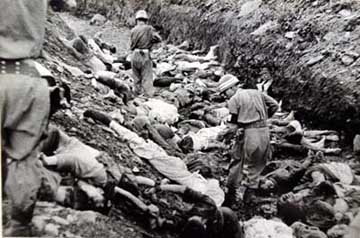
U.S. puppet
South Korean army massacred more than 1,800 Communist prisoners at Taejong
in July 1950. Amsterdam housing project in October 1992, killing 43. (Photo: AP)
In North Korea, the U.S. policy of mass murder was carried out on an industrial scale. Napalm (jellied gasoline) and phosphorous bombs were systematically dropped in order to incinerate every city north of the 38th parallel (roughly marking the line between capitalist South Korea and the bureaucratically deformed workers state to the north). The North Korean capital was a particular object of Washington’s murderous fury. On 11 July 1952, the U.S. Air Force dropped 1,400 tons of bombs and 23,000 gallons of napalm on Pyongyang, leveling more than 1,500 buildings and killing many thousands. The American bombers returned on August 4 and again on August 29 to finish the job. By that time there was literally nothing left to hit. And not just in the north. General Curtis LeMay described the devastation saying, “we eventually burned down every town in North Korea... and some in South Korea too. We even burned down [the South Korean city of] Pusan – an accident, but we burned it down anyway” (from the PBS TV program, Race for the Superbomb, January 1999). It is well-known that General Douglas MacArthur unsuccessfully pushed to A-bomb Chinese and North Korean forces in Korea and even Chinese industrial centers north of the Yalu. It is seldom reported, however, that from the very beginning of the Korean War, in August 1950 U.S. president Truman moved ten B-29s loaded with atomic bombs to Guam, that Eisenhower moved them up to Okinawa in 1953 to force the Soviets to accept an armistice, and that the U.S. actively considered using atomic weapons throughout the war. More than 2 million Korean civilians and another 1.5 million soldiers were killed in the Korean War, overwhelmingly by the U.S. and its allies. Today, U.S. president Bush again threatens “pre-emptive” action against North Korea’s tiny nuclear facilities, claiming they are a “threat” to the United States. In fact, it is U.S. imperialism which has not only threatened but carried out mass killings with chemical weapons in an attempt to obliterate North Korea. As we stressed in “Defend North Korea Against Nuclear Blackmail and War Threats!” (The Internationalist No. 15, January-February 2003): the Democratic People’s Republic of Korea has the right to obtain any weapon it requires to defend itself against the imperialist mass murderers, and it is the obligation of every class-conscious worker and opponent of imperialism to defend North Korea against U.S. nuclear threats. Vietnam 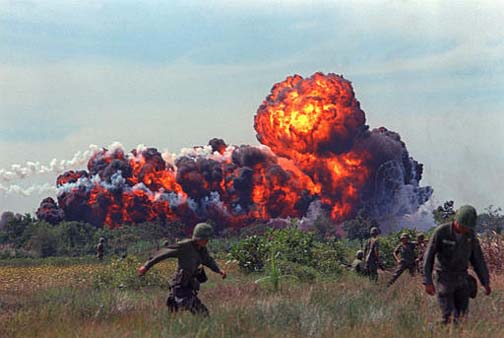
In Vietnam, the massive use of chemical warfare by the United States is notorious. The U.S. Air Force dropped over 338,000 tons of napalm on Vietnam between 1963 and 1971 as well as more than 100,000 tons of herbicides. The napalm had been “improved” over that used by the U.S. in Korea and the French in Algeria, combining it with magnesium and phosphorous so that it burned at much higher temperatures. In addition to the gruesome deaths due to the burns and carbon monoxide poisoning caused by napalm, hundreds of thousands were killed by the “carpet-bombing” from B-52s. The resulting toll of civilian deaths was not inadvertent “collateral damage,” but an intended result. To Mao Zedong’s aphorism that guerrilla fighters among the people were like fish swimming in the water, the Pentagon counterinsurgency experts responded: “If you want to kill the fish, you remove the water. If you want to kill the guerrilla, you remove the people.” The people were “removed” by rounding them up in concentration camps (the “strategic hamlet” program) or simply killing them wholesale. In the CIA-designed Operation Phoenix, U.S. commandos (including one commanded by former U.S. senator Bob Kerrey) deliberately murdered tens of thousands of Vietnamese (see “Drive Out War Criminal Bob Kerrey!” The Internationalist No. 10, June 2001). 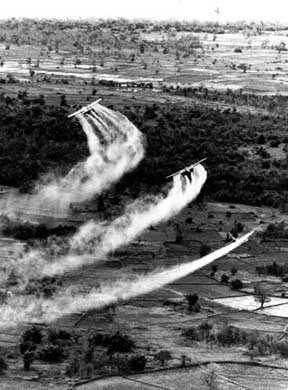
Planes spraying
Agent Orange defoliant on Vietnam in 1966. Over 100,000 tons of herbicides
(Agents Blue, Orange, Pink, Purple and White) were dropped on Vietnam
in attempt to deprive Viet Cong of food and forest cover. New study shows
2 to 4 million people were sprayed directly with the chemicals which contained
concentrations of dioxin more than 100 times greater than normal. In additional
to killing many thousands, U.S. chemical warfare left legacy of half a million
Vietnamese children suffering from birth defects, according to the Wall
Street Journal. (Photo: AP)
U.S. imperialist rulers would dearly like the Vietnam War to be forgotten or relegated to the category of ancient history, but a quarter century later White House and Pentagon war planners are still trying to overcome the “Vietnam syndrome” in the American population – that is, the revulsion at a dirty, losing colonial war. And revelations about the wanton slaughter carried out there in the name of “defending democracy” continue to surface. The latest is a study published in the British scientific magazine Nature (17 April) by Jeanne Mager Stellman of the Columbia University School of Public Health reporting that the quantities of defoliants used in Vietnam, and the concentrations of dioxin (2,4,5-T) were “up to four times as great as previously estimated.” In a program originally known as Operation Hades (later changed to the innocuous-sounding Operation Ranch Hand), the Pentagon used not only Agent Orange but also significant quantities of the even more potent Agent Blue and Agent Purple in order to destroy crops in heavily populated areas of Vietnam (“food deprival”). These poisons, whose concentrations of toxic chemicals were more than 100 times greater than commercial weed killers, were sprayed directly on at least 3,000 Vietnamese villages populated by 2 to 4 million people. Hoping to obliterate the memory of its war crimes in Indochina, or at least to relativize them, beginning in 1975 the U.S. accused the Soviet Union of using chemical warfare in Southeast Asia. If the U.S. used Agent Orange, they charged, the Soviets used “Yellow Rain” (trichothecene mycotoxins). As Washington stepped up its war against the Soviet forces in Afghanistan in the early 1980s, a propaganda blitz was organized around this claim. In September 1981, General Alexander Haig, then Reagan’s ambassador to the United Nations, announced with great fanfare that “the Soviet Union and its allies have been using lethal chemical weapons in Laos, Kampuchea, and Afghanistan.” However, when a group of scientists led by Harvard molecular biologist Matthew Meselson looked at the evidence, they concluded that the “rain” was showers of yellow feces from swarms of giant Asian honeybees (see Julian Robinson, Jeanne Guillemin and Matthew Meselson, “Yellow Rain in Southeast Asia: The Story Collapses,” Foreign Affairs, Fall 1987, for a recounting of this saga). U.S. imperialism tried to bury its own massive use of chemical arms in Indochina under a pile of bee shit. The U.S. chemical warfare against the Vietnamese people killed many thousands, and left a legacy of an estimated 500,000 children with serious birth defects (Peter Waldman, “Body Count,” Wall Street Journal, 12 December 1997). Overall, upwards of 3 million people were killed in the U.S.’ counterrevolutionary war on Vietnam, plus another 2 million in neighboring Cambodia and Laos. This horrendous death toll was justified with overtly racist arguments. The commander of U.S. forces in Vietnam, General William Westmoreland, claimed that, “The Oriental doesn't put the same high price on life as does a Westerner. Life is plentiful, life is cheap in the Orient” (Far Eastern Economic Review, 21 April 1975). The same grotesque arguments are used by the apologists for the U.S. imperialist invasion of Iraq today. |
To contact the Internationalist Group and the League for the Fourth International, send e-mail to: internationalistgroup@msn.com
